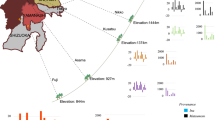Abstract
In this paper, it is studied that the growth characters of the progeny of 16 provenance oflarix gmelinii within the all 13 experimental sites by means of the analysis of variance, provenance stability, productivity index, rank correlation, synthetic index selection and PCA.The provenances were divided into three patterns: The first type have low and steady productivity; The second type have high but unsteady productivity; The third type is between the productivity of the first and second type. Through the analysis on the feasibility and the reliability of the provenance early selection, the best provenances which lie in the southeast of the Xiaoxingan Mt. are regarded as the best and suitable for a large afforestation areas ofLarix gmelinii. Then in the north of Xingan Mt., the local or the northwest provenances of the Xiaoxingan Mt. should be used. The genetic gain was calculated on the basis of the provenance heritability and the utilization of the best provenance were evaluated in this paper.
Similar content being viewed by others
References
(I) 1990, 18 (3)
1982
1982
1982
BASIC, 1985
l986
1981
1986
M. A. K. Khalil, 1985
Author information
Authors and Affiliations
Rights and permissions
About this article
Cite this article
Chuanping, Y., De’an, X., Chuiqing, X. et al. Study on the provenance test of Dahurian Larch selection of best provenance. J. Northeast For. Univ. 4, 22–30 (1993). https://doi.org/10.1007/BF02897271
Issue Date:
DOI: https://doi.org/10.1007/BF02897271




